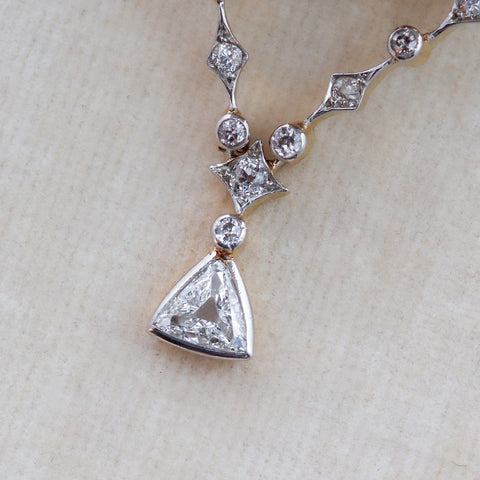
Trillion Cut
Trillion cut diamonds, like so many other modern diamond cuts, got their start centuries ago. It was the 1700s, a time when royals were beginning to become fascinated with unique new diamond cuts and new diamond sources were being discovered in Brazil, most of which would be shipped to Amsterdam for cutting. It was here that a pair of brothers with the last name Asscher (ancestors to the creator of the Asscher cut) cut the first recorded triangular diamond. While this means triangular cuts existed at the time, they were still fairly rare, and it would be quite some time before the faceting was perfected.
Modernizing Another Antique Cut
Fast forward a couple hundred years to the 1960s: lapidaries have been capitalizing on Tolkowsky’s discoveries for decades, creating diamonds of different shapes which provided a luxurious sparkle. A lapidary named Leon Finker was the first to unlock the brilliance inside a triangular diamond.
Initially, Finker decided against trademarking/patenting his creation, and by the time he decided to patent his innovative new cutting technique, the “trillion cut” had become so popular that it was used as a blanket term for all triangular cut stones.
Nowadays, the term “trillion cut” is still seen as a generic term used to represent all triangular diamonds, whether they be brilliant or step cuts. The modern trillion cut diamond has 3 equal sides and anywhere from 31 to 50 facets. Some trillions have sharp corners, some have curved corners, some have slightly curved sides, some have a look similar to a modified shield cut.
Trillion cuts are most often used as an accent stone, and they can also stand alone as a modernized solitaire pendant or stud earring.
The Ocean Dream Diamond
Most likely the most valuable trillion cut diamond in existence, the Ocean Dream Diamond weighs in at a modest 5.51ct, but grades as “Fancy Deep Blue-Green” in color. The Ocean Dream Diamond was the first and is one of only two diamonds ever to be graded by GIA as “blue-green” in color. This beautiful stone was originally discovered in 2002 and was owned by Cora Diamond Corporation, until 2014 when it was sold to an anonymous collector by Christie’s for $8.6m.

 An Antique Trillion Cut Diamond Dangling From an Art Deco Necklace - Circa 1920s
An Antique Trillion Cut Diamond Dangling From an Art Deco Necklace - Circa 1920s